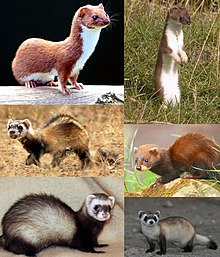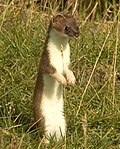Weasel
| Weasel | |
|---|---|

| |
| Clockwise from top left: Least weasel, stoat, European polecat, black-footed ferret, ferret and steppe polecat | |
| Scientific classification | |
| Domain: | Eukaryota |
| Kingdom: | Animalia |
| Phylum: | Chordata |
| Class: | Mammalia |
| Order: | Carnivora |
| Family: | Mustelidae |
| Subfamily: | Mustelinae |
| Genus: | Mustela Linnaeus, 1758 |
| Type species | |
| Mustela erminea | |
| Species | |
| |

| |
| Mustela range | |
Weasels /ˈwiːzəlz/ are mammals of the genus Mustela of the family Mustelidae. The genus Mustela includes the least weasels, polecats, stoats, ferrets, and European mink. Members of this genus are small, active predators, with long and slender bodies and short legs. The family Mustelidae, or mustelids (which also includes badgers, otters, and wolverines), is often referred to as the "weasel family". In the UK, the term "weasel" usually refers to the smallest species, the least weasel (M. nivalis),[1] the smallest carnivoran species.[2]
Least weasels vary in length from 173 to 217 mm (6+3⁄4 to 8+1⁄2 in),[3] females being smaller than the males, and usually have red or brown upper coats and white bellies; some populations of some species moult to a wholly white coat in winter. They have long, slender bodies, which enable them to follow their prey into burrows. Their tails may be from 34 to 52 mm (1+1⁄4 to 2 in) long.[3]
Weasels feed on small mammals and have from time to time been considered vermin because some species took poultry from farms or rabbits from commercial warrens. They do, on the other hand, eat large numbers of rodents. Their range spans Europe, North America, much of Asia and South America, and small areas in North Africa.
Terminology
The English word "weasel" was originally applied to one species of the genus, the European form of the least weasel (Mustela nivalis). This usage is retained in British English, where the name is also extended to cover several other small species of the genus. However, in technical discourse and in American usage, the term "weasel" can refer to any member of the genus, or to the genus as a whole. Of the 16 extant species currently classified in the genus Mustela, 10 have "weasel" in their common names. Among those that do not are the three species of ermine,[* 1] the polecats, the ferret, and the European mink.[4]: 12
The American mink and the extinct sea mink were commonly included in this genus as Mustela vison and Mustela macrodon, respectively, but in 1999 they were moved to the genus Neovison.[5] In 2021, both Neovison species, along with the long-tailed weasel (Mustela frenata), Amazon weasel (Mustela africana) and Colombian weasel (Mustela felipei) were moved to the genus Neogale, as the clade containing these five species was found to be fully distinct from Mustela.[6]
Taxonomy
The genus name Mustela comes from the Latin word for weasel combining the words mus meaning "mouse" and telum meaning "javelin" for its long body.[4]: 3
Species
The following information is according to the Integrated Taxonomic Information System and MammalDiversity.
| Image | Scientific name | Common name | Distribution |
|---|---|---|---|
 |
Mustela altaica Pallas, 1811 | Mountain weasel | Northern and Southern Asia |
| Mustela lutreolina Robinson and Thomas, 1917 | Indonesian mountain weasel | Southern Asia | |
 |
Mustela erminea Linnaeus, 1758 | Stoat, Beringian ermine, Eurasian ermine, or short-tailed weasel |
Europe and Northern Asia Arctic Canada and Alaska (United States) Southern Asia (non-native) New Zealand (non-native) |
 |
Mustela nivalis Linnaeus, 1766 | Least weasel | Europe, North Africa and Northern Asia North America Southern Asia (non-native) New Zealand (non-native) |
| Mustela aistoodonnivalis Wu & Kao, 1991 | Missing-toothed pygmy weasel | Shaanxi and Sichuan, China | |

|
Mustela richardsonii Bonaparte, 1838 | American ermine | Most of North America south of Alaska and the Arctic Circle; eastern Nunavut and Baffin Island |

|
Mustela haidarum Preble, 1898 | Haida ermine | Haida Gwaii (British Columbia, Canada) and Alexander Archipelago (Alaska, United States) |
 |
Mustela eversmanii (Lesson, 1827) | Steppe polecat | Southeast Europe and Northern Asia Southern Asia |

|
Mustela furo Linnaeus, 1758 | Domestic ferret | Domestic
Worldwide (domesticated); New Zealand (non-native) |
 |
Mustela putorius Linnaeus, 1758 | European polecat | Europe, North Africa and Northern Asia |
 |
Mustela itatsi Temminck, 1844 | Japanese weasel | Japan and formerly Sakhalin Island, Russia |
 |
Mustela sibirica Pallas, 1773 | Siberian weasel | Europe and Northern Asia Southern Asia |
 |
Mustela kathiah Hodgson, 1835 | Yellow-bellied weasel | Southern Asia |
 |
Mustela lutreola (Linnaeus, 1761) | European mink | Europe |
 |
Mustela nigripes (Audubon and Bachman, 1851) | Black-footed ferret | North America |
| Mustela nudipes Desmarest, 1822 | Malayan weasel | Southern Asia | |
 |
Mustela strigidorsa Gray, 1855 | Back-striped weasel | Southern Asia |
1 Europe and Northern Asia division excludes China.
Cultural meanings
Weasels have been assigned a variety of cultural meanings.
In Greek culture, a weasel near one's house is a sign of bad luck, even evil, "especially if there is in the household a girl about to be married", since the animal (based on its Greek etymology) was thought to be an unhappy bride who was transformed into a weasel[7] and consequently delights in destroying wedding dresses.[8] In Macedonia, however, weasels are generally seen as an omen of good fortune.[7][8]
In early-modern Mecklenburg, Germany, amulets from weasels were deemed to have strong magic; the period between 15 August and 8 September was specifically designated for the killing of weasels.[9]: 255
In Montagne Noire (France), Ruthenia, and the early medieval culture of the Wends, weasels were not meant to be killed.[9]
According to Daniel Defoe also, meeting a weasel is a bad omen.[10] In English-speaking areas, weasel can be an insult, noun or verb, for someone regarded as sneaky, conniving or untrustworthy. Similarly, "weasel words" is a critical term for words or phrasing that are vague, misleading or equivocal.
Japanese superstitions


In Japan, weasels (
They are also said to shapeshift like the fox (kitsune) or tanuki, and the nyūdō-bōzu told about in legends in the Tōhoku region and the Chūbu region are considered weasels in disguise, and they are also said to shapeshift into ōnyūdō and little monks.[11]
In the collection of depictions, the Gazu Hyakki Yagyō by Sekien Toriyama, they were depicted under the title
In Japanese, weasels are called iizuna or izuna (
According to the folklorist Mutō Tetsujō, "They are called izuna in the Senboku District,[* 2] Akita Prefecture, and there are also the ichiko (itako) that use them."[16] Also, in the Kitaakita District, they are called mōsuke (
In the Ainu language, ermines are called upas-čironnup or sáčiri, but since least weasels are also called sáčiri, Mashio Chiri surmised that the honorary title poy-sáčiri-kamuy (where poy means "small") refers to least weasels.[17]
Kamaitachi
Kamaitachi is a phenomenon wherein one who is idle is suddenly injured as if his or her skin were cut by a scythe. In the past, this was thought to be "the deed of an invisible yōkai weasel". An alternate theory, asserts that kamaitachi is derived from kamae Tachi (
See also
Notes
- ^ These three species are Mustela erminea, (the Eurasian ermine or stoat); M. haidarum, (the Haida ermine); and M. richardsonii, (the American ermine).
- ^ However, in the Senboku District, especially in Obonai village (
生保内 村 ), they are called okojo.[16]
References
- ^ Shorter Oxford English dictionary. United Kingdom: Oxford University Press. 2007. p. 3804. ISBN 978-0199206872.
- ^ Valkenburgh, Blaire Van; Wayne, Robert K. (9 November 2010). "Carnivores". Current Biology. 20 (21): R915–R919. Bibcode:2010CBio...20.R915V. doi:10.1016/j.cub.2010.09.013. ISSN 0960-9822. PMID 21056828. S2CID 235312150.
- ^ a b "The Weasel". The Mammal Society. Retrieved 11 April 2017.
- ^ a b King, Carolyn M.; Powell, Roger A. (2006). The Natural History of Weasels and Stoats: Ecology, Behavior, and Management. Oxford University Press. ISBN 978-0-19-804113-9.
- ^ Abramov, A.V. 1999. A taxonomic review of the genus Mustela (Mammalia, Carnivora). Zoosystematica Rossica, 8(2): 357-364
- ^ Patterson, Bruce D.; Ramírez-Chaves, Héctor E.; Vilela, Júlio F.; Soares, André E. R.; Grewe, Felix (2021). "On the nomenclature of the American clade of weasels (Carnivora: Mustelidae)". Journal of Animal Diversity. 3 (2): 1–8. doi:10.52547/JAD.2021.3.2.1. ISSN 2676-685X. S2CID 236299740.
- ^ a b Lawson, John Cuthbert (2012). Modern Greek Folklore and Ancient Greek Religion: A Study in Survivals. Cambridge UP. pp. 327–28. ISBN 978-1-107-67703-6.
- ^ a b Abbott, George Frederick (1903). Macedonian folklore. Cambridge UP. pp. 108–109. Retrieved 13 February 2012.
- ^ a b Thomas, N.W. (September 1900). "Animal Superstitions and Totemism". Folk-lore. 11 (3): 228–67. doi:10.1080/0015587X.1900.9719953. JSTOR 1253113.
- ^ Hazlitt, William Carew; Brand, John (1905). Faiths and folklore: a dictionary of national beliefs, superstitions and popular customs, past and current, with their classical and foreign analogues, described and illustrated. Reeves and Turner. p. 622. Retrieved 13 February 2012.
- ^ a b
村上 健司 編著 『妖怪 事典 』毎日新聞社 、2000年 、36頁 。ISBN 978-4-6203-1428-0。 - ^
高田 衛 監修 稲田 篤信 ・田中 直 日 編 『鳥山 石燕 画図 百鬼夜行 』国書刊行会 、1992年 、50頁 。ISBN 978-4-336-03386-4。 - ^
少年 社 ・中村 友紀 夫 ・武田 えり子 編 『妖怪 の本 異 界 の闇 に蠢 く百鬼夜行 の伝説 』学習 研究 社 〈New sight mook〉、1999年 、123頁 。ISBN 978-4-05-602048-9。 - ^
草野 巧 『幻想 動物 事典 』新 紀元 社 、1997年 、30頁 。ISBN 978-4-88317-283-2。 - ^ 『
広辞苑 第 4版 』(1991年 )、岩波書店 「いづなつかい【飯綱 使 ・飯 縄 遣 】」の項 - ^ a b c
武藤 ,鉄 城 (1940), "秋田 郡 邑魚譚 ", アチックミユーゼアム彙報 , 45: 41–42,
。北秋田 ではモウスケと称 して狐 より怖 がられ、仙北 地方 ではイヅナと称 し、それを使 う巫女 (エチコ)もある。学名 コエゾイタチを、此の付近 ..〔生保内 村 〕では..オコジョと云 ふ(田口 耕 之 助 氏 ) - ^
知里 ,真志保 (Chiri, Mashiho) (30 March 1959), "アイヌ語 獣 名 集 (On the names of the mammals of the Ainu language)" (PDF),北海道大學 文學部 紀要 = the Annual Reports on Cultural Science: 141, ISSN 0437-6668, archived (PDF) from the original on 9 October 2022{{citation}}: CS1 maint: multiple names: authors list (link) - ^
人文 社 編集 部 (2005).諸国 怪談 奇談 集成 江戸 諸国 百 物語 東日本 編 . ものしりシリーズ.人文 社 . p. 104. ISBN 978-4-7959-1955-6.
Further reading
- Nowak, Ronald M., and Ernest P. Walker. Walker's Carnivores of the World. Baltimore: Johns Hopkins University Press, 2005. ISBN 0-8018-8033-5, ISBN 0-8018-8032-7.
- C. Hart Merriam, Synopsis of the Weasels of North America, Washington, Government Printing Office, 1896.
- Angier, Natalie (13 June 2016). "Weasels Are Built for the Hunt". The New York Times. Retrieved 15 June 2016.
